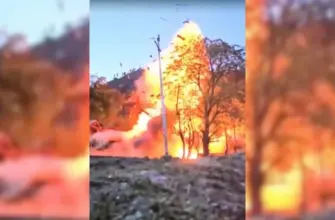A devastating explosion and subsequent fire ripped through a port in southern Iran on Saturday, claiming eight lives and leaving approximately 750 people injured. The incident occurred at Shahid Rajaei port, just as representatives from Iran and the United States were engaged in negotiations in Oman concerning Tehran’s nuclear program.
While Iranian officials refrained from explicitly attributing the explosion to an attack, Foreign Minister Abbas Araghchi acknowledged heightened security measures due to “past instances of attempted sabotage and assassination operations.”
Key Details Emerging
- Casualties: Eight fatalities and around 750 injuries.
- Location: Shahid Rajaei port, near Bandar Abbas.
- Timing: Coincided with nuclear negotiations between Iran and the U.S.
Iranian Interior Minister Eskandar Momeni confirmed the casualty figures via state television, though details surrounding the initial cause of the blaze remained scarce. The fire raged into Saturday night, reportedly triggering further explosions among nearby containers.
Suspected Chemical Link
According to a private security firm, Ambrey, the port had received a shipment of “sodium perchlorate rocket fuel” in March – a key ingredient used in missile propellant. This shipment, originating from China and first reported by the Financial Times, was intended to replenish Iran’s missile stocks depleted during recent attacks on Israel related to the conflict with Hamas.
“The fire was reportedly the result of improper handling of a shipment of solid fuel intended for use in Iranian ballistic missiles,” stated Ambrey.
Ship-tracking data corroborated Ambrey’s account, placing one of the vessels believed to be carrying the chemical near the port during that timeframe. Iran has not officially acknowledged receiving this particular shipment.
Echoes of Beirut and Past Incidents
The incident raises questions regarding why the chemicals were not moved from the port, particularly in light of the catastrophic 2020 Beirut port explosion triggered by ammonium nitrate. That tragedy resulted in over 200 deaths and thousands of injuries.
Furthermore, Israel has previously targeted Iranian missile sites utilizing industrial mixers for solid fuel production.
Witness Accounts & Official Response
Graphic social media footage captured reddish-hued smoke emanating from the port prior to a powerful explosion, suggesting the involvement of chemical compounds – mirroring elements observed in the Beirut disaster. One video recorded a man urgently shouting:
“Get back, get back! Tell the gas (truck) to go! Tell him to go, it’s going to blow up! Oh God, this is blowing up! Everybody evacuate! Get back!”
The state-run IRNA news agency later attributed the blast to a “stockpile of hazardous goods and chemical materials stored in the port area,” providing minimal further detail. Aerial footage revealed multiple fires burning across the port, prompting warnings from authorities about air pollution stemming from chemicals like ammonia, sulfur dioxide, and nitrogen dioxide. Schools in Bandar Abbas will be closed on Sunday.
A Strategic Location & History of Attacks
Shahid Rajaei port holds significant strategic importance as a major destination for Iranian cargo and is located on the Strait of Hormuz – a vital waterway through which approximately 20% of global oil trade passes. The port has been targeted previously, notably by a 2020 cyberattack attributed to Israel, following Israeli claims of thwarting an Iranian cyberattack targeting its water infrastructure.
Witnesses described widespread damage from the explosion, with glass shattered kilometers away and scenes of injured individuals being transported to hospitals. An investigation into the incident has been launched by the Interior Ministry, and President Masoud Pezeshkian offered his condolences to those affected.






